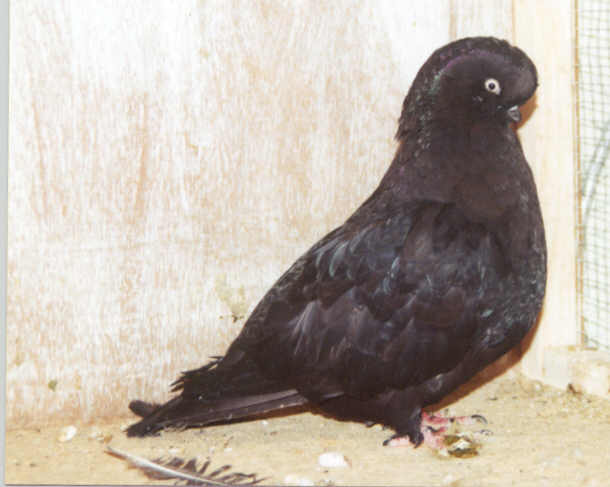
THE History Of The Long face Tumbler
by Robert D. Wood.
 |
Tumblers
are considered as one of the oldest known varieties of pigeons with their exact
place of origin unknown by reason of their very antiquity. Literature indicates
their existence in India before 1600 with their origin probably in the East and
later being brought to Europe. Early descriptions indicate the early tumblers
were small with many different colours and capable of flying at night and
ascending to great heights. A behaviour peculiar to the tumblers was described
as turning themselves back- wards over their heads. By the eighteenth century
the tumbler was de- scribed as being short of body, full breasted, thin-necked,
and spindle beaked with the Dutch Tumbler being larger than the English Tumbler
and sometimes possessing feathers on the feet. Common colours included blacks,
whites, reds, duns, yellows, blues, silvers, and almonds. Literature in the late
1700's described tumblers that were "baldpated" with a white head,
white flights, and white tail and also black and blue beards. Tumblers were bred
primarily for their aerial ability rather than for other characteristics with
more interest in the plumage by 1765.
During the
nineteenth century, development of the Short-faced tumbler occurred in England
with emphasis upon the show bird with its aerial ability eventually being lost.
Through selective breeding the tumbler with the remarkable short face and a
bulging frontal evolved while losing its ability to perform and becoming
strictly a show bird. By 1851 the colors included almond mottles, blue and black
bars, almonds ,kites, agates, and selfs, The wings were carried below the tail.
Other English breeders were improving the flying tumblers, which became known as
the Long-faced Tumblers. As breeders began to breed the Long-faced Tumblers for
the show room they also lost their aerial ability. The long faced tumblers
evolved into a bird with more frontal space be- Between the eye and upper beak
wattle and carried their tail folded over the tail. Show birds consisted of many
colors in both clean-legged and muffed tumblers. Some pigeon fanciers still
wanted to fly their tumblers rather than show thern resulting in the development
of the present day Rollers, Tipplers, and Flights. As interest in- creased with
the breeders wanting to show their birds, we see the development of the Snow
Tippler, the American Domestic Flights, and the Modem Show Flights.
The
Tumbler was one of the first breeds of pigeons imported to the United States.
According to early show records it apparently was one of the most popular fancy
breeds during the early history of Show pigeons. Early show records indicated
many colors and patterns including L.F.C.L. selfs, bars, baldheads, beards,
mottles proper, mottle rose wings, and mottle white sides and L.F. Muffed selfs,
bars, saddles, badges, beards, baldheads, mottle roswings, mottle Whiteside, and
motle almonds.
Information
was obtained from the THE PIGEON by Wendell M. Levi and Summarized by Robert D.
Wood.
** PIGEON DEBUT FEB1998